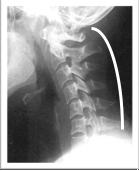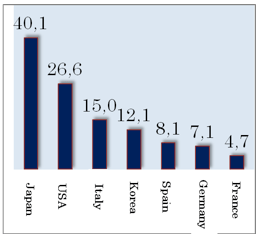An alternative interpretation of "Benign Paroxysmal Positional Vertigo."
--- Possibility of Central Paroxysmal Positional Vertigo
Morito Nakayama, M.D.
Department of Internal Medicine, Nukada Memorial Hospital
Kamakura, Japan
|

Summary : As aged segment of population increases and life style changes, more people are complaining about dizziness. Conventional explanation for this disease has been otolith theory, attributing the cause to inner ear disorder. New observations using MRI and MRA reveal possibility of brain blood flow disorder or Central Paroxysmal Positional Vertigo.
My observation : The benign paroxysmal positional vertigo is usually considered to be caused by otolith ( to be found in the vestibule of inner ear ) moving in internal-ear semicircular canals or otolith clinging to sensory organ in semicircular duct.
As a practicing internist, this reporter has been using brain magnetic resonance images (MRI) and magnetic resonance angiography (MRA) since 1988 in cases of vertigo or dizziness complaints. Since 1996, additional neck MRA was utilized regardless of diagnostic name. When neck MRA pictures were made, this reporter paid special attention so that the entire intracranial basilar artery from vertebral artery in lower neck appears in a single sheet of picture.
In recent years, magnetic-resonance apparatus was powered up to 3 teslas from 1.5 teslas, and even small cerebral aneurysm of 2 - 3 mm in size can be detected.
After a decade of practice as an otolaryngologist, this reporter moved to internal medicine and practiced more than 30 years. From this vantage point, and careful examinations of MRI and MRA pictures, this reporter started to realize there are cases of benign paroxysmal positional vertigo caused by internal ear disorder, yet, more importantly, there are numerous cases of temporary brain blood flow disorder causing vertigo or dizziness.
In other words, in the lack of proper diagnosis, there are probably more cases of central paroxysmal positional vertigo existing rather than benign positional vertigo. Dr. XXX , a known otolaryngologist, once spoke about similar observation saying when he was young he attributed benign paroxysmal positional vertigo to otolith in internal ear but as he accumulated experiences he started to see brain blood flow disorder ( central paroxysmal positional vertigo ) .
Some observations leading to this conclusion:
- There is a case of a patient diagnosed as typical benign paroxysmal positional vertigo and given anti-vertigo medicine but it was ineffective. When the same patient was given anti-viral agent ( medicine for herpes zoster) , the effect were dramatic. This was a case of middle-aged male, whose neck and shoulders were stiff like a wood board.
There is a reported case of a University Hospital in the US( XXX name) where a patient diagnosed as benign paroxysmal positional vertigo but did not respond to anti-vertigo medicine. The vertigo improved with anti-viral agent which was prescribed for an American physician by the instructions of this reporter. This patient had a past history of whiplash injury and had chronically severe stiffness of neck and shoulders.
The patients mentioned above had stiff necks and shoulders, meaning disturbed blood flow to the brain, and activated herpes zoster virus could have worsened the situation.
In general, vertigo caused by disturbed flow of blood to brain ( especially to vestibular nuclei of brain stem or vestibular cerebellum ) triggered by stiff neck/shoulders did not receive due attention up until now.
- As a practicing internist, this reporter encounters cases of cerebral infraction or myocardial infraction after one month to one year of vertigo attack. As an otolaryngilogist, one dos not see the patient once his/her dizziness disappears. In other words, one does not see the after-effect of vertigo cases. An internist could observe the whole process of vertigo syndrome and its after effects since he is also handling chronic diseases such as high blood pressure, diabetes, hyperlipidemia etc.
These cases suggest the necessity of wider view, not compartmentalized one, in evaluating vertigo and its cause.
When one stands at the wider vantage point, one realizes that most of vertigo cases are caused by circulatory disturbances ミ not only by local problems like inner ear damages. Human aging can be one example here. As human body is interconnected by nerve systems and blood vessels, and as one gets older, one tend to have arteriosclerosis, thus increasing possibilities of brain blood flow disturbances leading to dizziness.
(Japanese proverb says some people " See trees but not the forest behind" meaning paying too much attention to details, thus losing the sight of a bigger story.)
- There are frequent clinical cases of vertigo or dizziness caused by stiff neck/shoulders due to abnormalities of the cervical spine, such as ossification of posterior longitudinal ligament (Fig.1), ossification of anterior longitudinal ligament (Fig.2), straight neck (Fig.3), kyphotic neck (Fig.4) and cervical spondylosis.

|
|

|
Fig 1 ossification of posterior
longitudinal ligament
|
|
Fig 2 ossification of anterior
longitudinal ligament
|

|
|

|
|
Fig 3 straight neck
|
|
Fig4 kyphotic neck
|
The stiffness of shoulder/neck stimulates nerve surrounding vertebral artery causing shrinkage of vertebral artery. This contributes to blood circulation disorder, then brainstem or cerebellum falls into an ischemic condition temporarily causing vertigo or dizziness.
In these patients, peculiar "nystagmus (abnormal eye movement)" which cannot be distinguished from the "nystagmus" observed in the patient with "benign paroxysmal positional vertigoモ are often observed. Because of this similar syndrome, the above mentioned vertigo is diagnosed and treated as メbenign paroxysmal positional vertigo."
In recent years, dizziness caused by straight neck and kyphotic neck are increasing in number particularly with those persons who stoop over or look down. They take this posture for a long time to use smartphones, cellular phones, notebook-sized personal computers, tending cash registers at supermarkets, and reading books etc.
Contemporary life style, in other words, can be a cause of vertigo.
3-2 There were numerous clinical cases feeling dizzy when lower part of the neck was pressed. At that time the movement of patients eyes were same as benign paroxysmal positional vertigo. These cases indicate neck, not necessarily inner ear can be the cause of vertigo.
3-3 There are cases of disappearance of vertigo by applying Shiatsu (Japanese finger-pressure treatment) to sternocleidomastroid posterior border. This reporter experienced his own positioning vertigo disappear by this maneuver. Again, this indicates neck can be the cause of vertigo.
3-4 Since it is widely believed that benign paroxysmal positional vertigo is caused by internal ear disturbances, it is often ignored to obtain larger images of blood vessel covering subclavian artery to skull part where left and right vertebral arteries merge using MRI or MRA.
- As to the diffusion rate of magnetic-resonance apparatus, Japanese rate is distinctly high, making it possible to make above mentioned observations. Yet brain MRI and MRA may be frequently used in Japan recently, this reporter suspects the entire neck MRA for the cases of vertigo or diziness is still rare.

The diffusion rate of magnetic resonance apparatus in each country / the number per population of 1 million people ( 2005 OECD survey. The data was quoted from the internet )
Conclusion: More attention to vertigo caused by blood flow disturbances is necessary. Japan is a rapidly aging society. People born in 1947, the first baby boomers, have reached age 65 already and elderly people will still increase in number. While the entire society is heading toward elderly society, one out of three people over 65 are suffering from diabetes or possible diabetes. The persons of advanced age tend to have vascular lesions caused by high blood pressure and/or diabetes.
Under this kind of circumstances, it may not be appropriate if many people are diagnosed as メbenign paroxysmal positional vertigoモ patients caused by inner ear troubles. One report stated that head CT was used for 50 percent of benign paroxysmal positional vertigo cases, but CT was unnecessary. This reporter believes CT alone cannot detect small cerebral infractions, fine legions of brain, and serious cerebral vascular lesions. We need MRI and MRA for more accurate examinations.
The inner ear otolith theory of the benign paroxysmal positional vertigo is not a sole explanation of vertigo or dizziness. This observation has a growing support among otolaryngologists, neurosurgeons and neurologists around this reporter.
"The study that does not accept different opinions prevent progress" --- by Norinaga MOTOORI (1730-1801 well known Japanese classical scholar)
"世間の事物、進まざる者は必ず退き、退かざる者は必ず進む。Unless you progress, you retire. If you do not retire, you bound to progress" --- by Yukichi FUKUZAWA( 1835-1901 writer, politician, founder of Keio University)
|
|